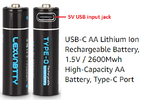Satoshi Deguchi
New Member
Hello,
I have some battery related questions.
According to this website, connecting batteries in series increases the voltage and connecting them in parallel increases current. Does this mean if I connect two AA sized batteries in parallel, with a maximum discharge rate of 5amps, the maximum discharge rate will be 10amps?
Context:
I plan to modify one of my flywheel Nerf blasters using AA sized LiFePo4 batteries from the OutOfDarts shop. The biggest roadblock is finding AA sized (or any that aren't Li-Po) batteries that have 10+ amps of discharge to meet the demands of the Honey Badger motors (22amps for a pair according to a modder). I've made the decision to not use Li-Po due to my concerns about it's safety/stability.
I have some battery related questions.
According to this website, connecting batteries in series increases the voltage and connecting them in parallel increases current. Does this mean if I connect two AA sized batteries in parallel, with a maximum discharge rate of 5amps, the maximum discharge rate will be 10amps?
Context:
I plan to modify one of my flywheel Nerf blasters using AA sized LiFePo4 batteries from the OutOfDarts shop. The biggest roadblock is finding AA sized (or any that aren't Li-Po) batteries that have 10+ amps of discharge to meet the demands of the Honey Badger motors (22amps for a pair according to a modder). I've made the decision to not use Li-Po due to my concerns about it's safety/stability.

